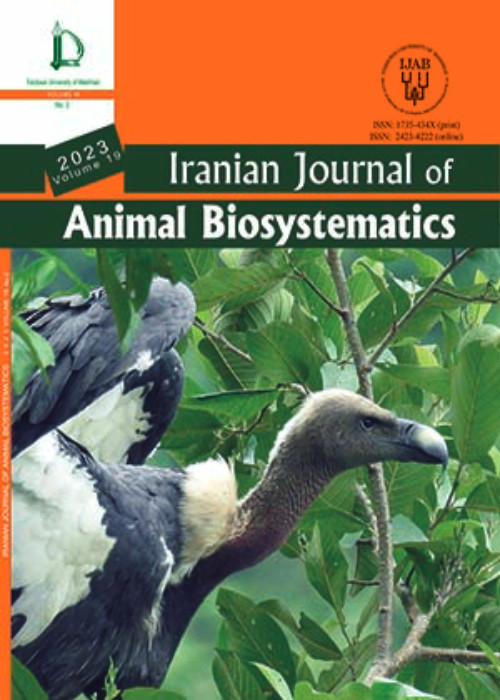فهرست مطالب
Iranian journal of animal biosystematics
Volume:16 Issue: 2, Summer-Autumn 2020
- تاریخ انتشار: 1399/10/29
- تعداد عناوین: 7
-
-
Pages 85-93
The order Amphipoda is one of the most diverse taxa that globally distributed in all environments and virtually habitats. The members of genus Niphargus represent an important part of the Western Palearctic subterranean amphipoda fauna. Accurate data on the occurrence and distribution of amphipods are only available for some regions. In this study, we were applied Parsimony analysis of endemicity (PAE) to analyze the distribution of amphipod freshwater genus Niphargus occurring strictly at the basin or sub-basin level along of Elburz and Zagros Mountains in Iran. The analysis was carried out using the computer program PAUP* 4.0a166, based on a data matrix built with 27 taxa and 13 areas for genus Niphargus. The rooting was made on a hypothetical all-zero out-group. Applying the exact algorithm heuristic search, the consensus tree was obtained with 30 steps, a consistency index of 0.9, and a retention index of 0.1. The procedure based on distributions of the 27 species of Niphargus delimited five areas of endemism in the study area with minimum two species. The high levels of endemism observed in West boundary rivers1 sub basin with six species and then in Urmia and West boundary rivers2 sub basins with three species.
Keywords: Niphargid species, Freshwater amphipods, Hydrological basins, Areas of endemism, Parsimony, Iran -
Pages 95-105
Bryobia rubrioculus (Scheuten, 1857), is one of the most important pests of spider mites in Hamedan province, western Iran. This species found on aerial part of deciduous and coniferous trees. All mobile stages (larvae, protonymph, deutonymph and adult female) of B. rubrioculus were reared on sweet cherry leaf in germinator under controlled condition and redescription in the present study. Furthermore, a key to Iranian species of the genus Bryobia is presented.
Keywords: Tetranychidae, brown mite, re-describtion, mobile stages, Iran -
Pages 107-130
The meiobenthic harpacticoids of the Persian Gulf and the Gulf of Oman has been almost unknown. During October 2014 to September 2016, interstitial and phytal harpacticoids were collected from tide pools in 30 different localities along the Iranian coast of the Persian Gulf and the Gulf of Oman. The new information on the distribution of 26 species and 12 families is provided, here. The most species-rich family was Laophontidae with seven species, followed by Miraciidae with four species. In this paper, all the species were considered new records for the area. Furthermore, the first checklist of meiobenthic Harpacticoids is provided.
Keywords: Harpacticoida, Meiobenthics, New records, Persian Gulf, Gulf of Oman, Iran -
Pages 131-144
Several studies have been carried out on the classification of freshwater fish (Icthyofauna) in all of Iraq or in the Tigris and Euphrates basin. The current study consisted of (82 specimens) were collected from three different regions within Babylon Province for seven months. Taxonomic status of specimens were studied depending on morphometric traits (biometrics), then preserved in 70% ethyl alcohol. Surveyed area included three main sites in Babylon province, which is located in the center of Iraq. The diagnostic results showed that the collected fish samples related to five families, nine genera, and twelve species, as following: Family cyprinidae (Aspius vorax, Barbus barbulus, B. luteus, B. xanthopterus, B. grypus, Carassius auratus, Cyprinus carpio); family Bagridae (Mystus pelusius); family Siluridae (Silurus triostegus); family Mugilidae (Planiliza) (Liza abu) and (L. subviridis); family Cichlidae (Tilapia zilli).
Keywords: Icthyofauna, fresh water, Biometrics, Babylon, Iraq -
Pages 145-154
The main purpose of this study was to investigate the morphological changes and body shape variations of the Zagros Tooth-carp Aphanius vladykovi populations in six water bodies located in Chaharmahal and Bakhtiari province, Iran. For this purpose, 240 specimens were collected from the Choghakhor and Gandoman wetlands, the Shalamzar, Balagholi, and Brovi springs, and the Beheshtabad River. Twelve landmark points were digitized on the right side of the fish. Statistical analyses including Principal Component Analysis (PCA), Discriminant Function Analysis (DFA), and Cluster Analysis (CA) were performed using TPS package, SYSTAT 9, and PAST Software. Discriminant function analysis revealed that female fish in different localities show more pronounced body shape differences compared to males from different localities (p <0.001). In addition, in clustering analysis performed among males and among females, two clusters were resolved, which were fairly similar for males and females. These differences might be attributed to the morphological adaptation of the Zagros Tooth-carp to their habitats but a clear inference on the observed morphological divergence will be possible with more genetic, ecological, and experimental evidence.
Keywords: Zagros tooth-carp, morphology, landmark, Ecological conditions -
Pages 155-170
In this study, 68 specimens of the Levant Green Frog, Pelophylax bedriagae, were collected from agricultural fields around Yasouj and Noor-Abad cities, from August 2018 to May 2019 in southern Iran to investigate the blood cell morphology. Blood specimens were taken from the heart, or abdominal and facial veins. Smears were dried in room temperature, fixed by methanol and stained using Giemsa method. Blood cells (erythrocytes and leucocytes) were counted and measured using light microscopy under an optical micrometer. Based on the findings of this study, erythrocytes from Noor-Abad population has significantly greater values from those in Yasouj population in all of the six metric characters (P < 0.05). RBC’s in male frogs are also greater than those in females in all six studied characters (P < 0.05). All studied metric characters in lymphocytes are also different between tow localities and sexes (P < 0.05).
Keywords: RBC, Leucocyte, Yasouj, Noor-Abad, Hematology -
Pages 171-175
Odontothrips biuncus John, 1921 is newly recorded for the fauna of Iran. The genus Odontothrips Amyot & Serville, 1843 (Thripidae: Thripinae) now includes seven species in Iran. A key is provided to identifying of Iranian species of the genus Odontothrips.
Keywords: Odontothrips, key, morphology, Iran


